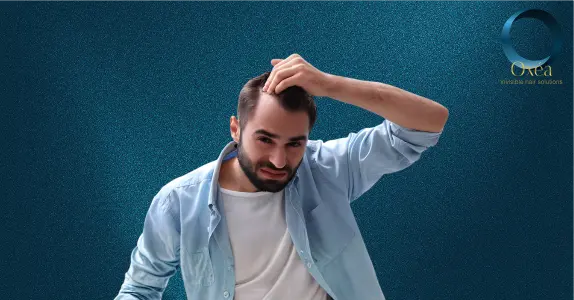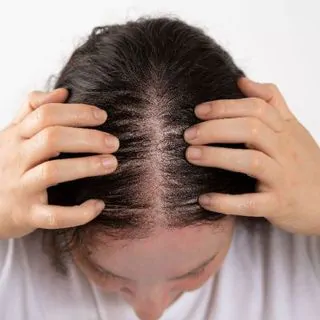



Contact our specialists now for Hair Replacement!
Temple hair loss is when hair thins or falls out around your temples(the parts above your ears extending toward your forehead). If you see your hairline moving back, scalp showing, or patches starting near the temples, you’re not alone.
Many people ignore these early signs.
In this blog, you will learn what temple hair loss is, how it shows in men and women, why it happens, what you can do now to stop it, and how non-surgical solutions (like hair systems or wigs) can give you confidence while natural regrowth works.
Temple hair loss refers to the gradual thinning and recession of hair specifically at the temporal regions of your scalp, those areas on either side of your forehead, just above your ears. It’s where your hairline meets your forehead at the sides.
This can happen gradually or more suddenly. The causes vary. Some are temporary; others are permanent if not addressed early.
Men vs Women
Women and men can both get temple hair thinning, but the patterns differ. Below is a simple table comparing:
Feature
Men
Women
Common pattern
Receding hairline at temples, changing “M” shape.
More diffuse thinning, sometimes slight temple recession.
Role of hormones
Strong link to DHT, androgen sensitivity.
Hormonal fluctuations (menopause, PCOS) can lead to a lower DHT effect.
Speed
Often faster once started.
Usually slower, it may remain mild for a long time.
Likelihood of transplant or permanent loss
Higher if late stage.
More risk of diffuse thinning, less dramatic temple recession.
Here is what most articles won’t tell you: the symptoms go far beyond just seeing less hair.
Asymmetrical thinning: One temple often recedes faster than the other, creating an unbalanced appearance.
Increased hair on your pillow: You wake to find more hair on your pillowcase, concentrated from the sides of your head.
This is where competitors’ articles fall short. They don’t acknowledge that hair loss on the temples affects your mental well-being, often before it becomes visibly obvious to others.

The most common cause. In men, DHT (a hormone) shrinks follicles in sensitive areas like the temples. Over time, they produce thinner hair, then no hair.
In women, it causes diffuse thinning; temple recession is less sharp but possible.
Caused by repeated tension (tight ponytails, braids, extensions). The temples are vulnerable. If caught early, damage may be reversible.
Note – Traction alopecia commonly occurs in Afro-Caribbean hairstyles that involve tight braids. Hair loss typically begins in childhood and may initially be reversible. The condition follows a biphasic pattern, with early-stage disease being nonscarring and reversible, while chronic cases result in permanent scarring alopecia.
A shock (stress, surgery, illness, crash diet) pushes many hair follicles into the resting phase.
You’ll see shedding across the scalp, but temples often show earlier because hair is already less dense there.
Conditions like frontal fibrosing alopecia (especially in post-menopausal women) damage hair follicles irreversibly, replacing them with scar tissue.
Also, lichen planopilaris, central centrifugal cicatricial alopecia may affect edges.
A patch of hair loss (often stable) in the temple area from childhood. Usually non-progressive.
Repeated heat, chemical treatments, bleaching near the hairline and overbrushing may damage the shaft (e.g. trichorrhexis nodosa) or injure follicles.
Thyroid disorders, PCOS, menopause, postpartum hormonal shifts, low oestrogen or thyroid imbalance can play a role.
Low iron, zinc, protein deficiency, vitamin D, and B vitamins — these weaken follicles.
Also, reduced blood flow or microvascular issues in the temple region may exacerbate the issue (a few articles mention that, so this is a gap to emphasise).
Alopecia areata can cause patchy hair loss that may include the temples.
Some medications (anti-inflammatories, hormones, chemotherapy) cause hair loss, including temples.
Aspect
Men
Women
Primary cause
Androgenetic alopecia (male pattern baldness) is driven by genetic DHT sensitivity.
Multiple factors: androgenetic alopecia, hormonal fluctuations, traction alopecia, frontal fibrosing alopecia.
Typical age of onset
Late teens to early thirties, progressing steadily.
Late twenties to fifties, often accelerating during hormonal transitions (pregnancy, perimenopause, menopause).
Progression rate
Generally steady and predictable, following Norwood scale stages; can progress rapidly in some cases.
More variable and unpredictable; may fluctuate with hormonal changes; can accelerate suddenly or plateau for years.
Hair texture changes
Follicles miniaturise, producing increasingly fine, short, unpigmented vellus hairs before stopping entirely.
Hair becomes finer and less dense but may retain some pigmentation longer; women often retain more vellus hairs.
Genetic disposition
Strong genetic component; 80% predictable from family history; both maternal and paternal genes involved.
Genetic factors present but less predictable; multiple genes involved; family history less reliable predictor.
Hormonal factors
Primarily DHT sensitivity; testosterone levels may be normal but conversion to DHT is key; it rarely involves thyroid or other hormones.
Complex hormonal interactions: oestrogen, progesterone, androgens, thyroid hormones, prolactin; PCOS, menopause, and pregnancy are all significant.
Associated conditions
Generally occurs as an isolated condition; cardiovascular risk may be elevated in early-onset cases.
Often accompanied by other hormonal symptoms: menstrual irregularities, PCOS, thyroid disorders, and iron deficiency anaemia.
Traction alopecia risk
Lower risk primarily affects those with tight hairstyles, man buns, cornrows, or sports helmets.
Much higher risk; years of ponytails, braids, hair extensions, and tight updos contribute significantly to temple thinning.
Psychological impact
Significant but somewhat normalised socially, it still affects self-esteem, perceived attractiveness, and confidence.
Profoundly distressing; female hair loss is less socially accepted; greater impact on self-identity and emotional well-being.
Styling adaptations
Shorter styles often work better; some embrace the bald look; less pressure to conceal thinning.
More styling pressure, longer hair to camouflage, fringe adjustments, toppers and extensions are more commonly used.
Treatment urgency
Moderate urgency; earlier treatment is more effective, but progression is predictable.
Higher urgency for diagnosis; distinguishing the cause is critical; some causes (FFA) require prompt treatment to prevent permanent loss.
Nutritional factors
Less commonly causative unless severely deficient, iron deficiency is rare in men.
Frequently contributory; iron deficiency is extremely common in menstruating women; dietary restrictions and dieting play a larger role.
Stress-related loss
Less common as a primary cause; may accelerate existing androgenetic alopecia.
More susceptible to telogen effluvium from stress, illness, and childbirth; temples are often the first visible area affected.
Women shouldn’t assume their temple thinning is the same as male pattern baldness, and men shouldn’t overlook potential underlying health conditions. Both benefit from proper diagnosis before rushing into treatment.
Here you will find the solutions that work:
A topical solution or water-based formulation applied directly to the scalp. It’s available over-the-counter in 2% and 5% concentrations.
An oral medication taken daily, available by prescription. The standard dose for hair loss is 1mg daily.
Similar to finasteride but more potent. It blocks both Type I and Type II 5-alpha-reductase enzymes, reducing DHT by approximately 90% (compared to finasteride’s 70%).
An oral medication that blocks androgen receptors and reduces testosterone production. Originally a blood pressure medication.
Taking minoxidil as a tablet rather than applying it topically. Doses for hair loss are very low (0.25-5mg daily) compared to the high doses used for blood pressure.
A procedure where your blood is drawn, processed to concentrate platelets, and then injected into your scalp. Platelets contain growth factors that may stimulate follicles.
A well-fitted hair system can cover thinning temples instantly. It is non-invasive, customizable (colour, density, texture), and allows you to look good while healing or regrowth happens. It’s a valid temple hair loss solution.
Medical devices (combs, caps, helmets) that emit specific wavelengths of red light onto the scalp.
Tiny pigment dots create the illusion of follicle density near temples. Good for mild recession or to complement hair systems.
These give a temporary visual lift — good for events or daily confidence boosts.
Creating microinjuries encourages regeneration when combined with growth serums.
This is called temple hair loss, which is often a sign of androgenetic alopecia (male or female pattern baldness), which is primarily genetic.
Other factors include hormonal changes, high stress (telogen effluvium), nutritional deficiencies, or traction alopecia from tight hairstyles. A proper diagnosis from a professional can identify the exact cause.
The most common cause in both genders is genetic: male pattern baldness (forming an ‘M’ shape) or female pattern baldness (general thinning, sometimes affecting temples).
Early signs include noticing a general decrease in hair density around the temples, which can make the scalp more visible.
Natural regrowth is possible if the hair loss is caused by temporary factors like stress, diet deficiency, or tight hairstyles (traction alopecia).
If the cause is genetic (pattern baldness), natural methods like scalp massage and essential oils can support remaining hair, but medical treatments or transplants are typically needed for significant regrowth.
Temple thinning specifically refers to a loss of density in the hair at the sides of the forehead.
A receding hairline is a progression where the entire front hairline moves backwards, often starting with temple thinning.
Effective treatments depend on the cause, but often include FDA-approved medications like topical Minoxidil and oral Finasteride.
For more advanced loss or to achieve a new hairline, Platelet-Rich Plasma (PRP) therapy, non non-surgical hair loss solution or a hair transplant works.
You are not powerless.
Whether you’re dealing with early thinning or advanced recession, whether you’re a man in your twenties or a woman going through menopause, there are proven, effective options available to you right now.
Start with understanding. Know what type of hair loss at temples you’re experiencing. Get a proper diagnosis. Address underlying health issues. Then, choose your path forward.
If you want immediate results and confidence whilst pursuing long-term treatments, Oxea London’s hair systems offer natural-looking solutions that let you live your life fully whilst your treatments work.
Megan Brooks is a Certified Trichologist at Oxea Invisible Hair Solutions with over 21 years of Unbeatable experience. Throughout her remarkable career, she has successfully completed an impressive 8000+ hair replacement systems. Megan is dedicated to transforming lives and boosting self-confidence so that one can live with all the pride. She has served over 800 satisfied clients and still-counting, while helping them regain their natural appearance and feel their best.